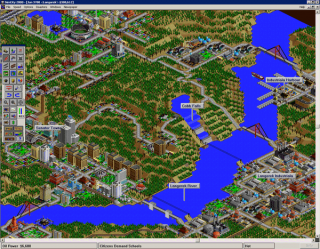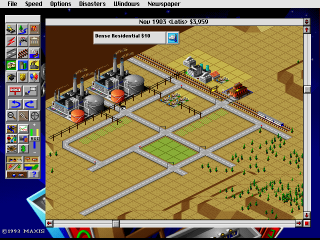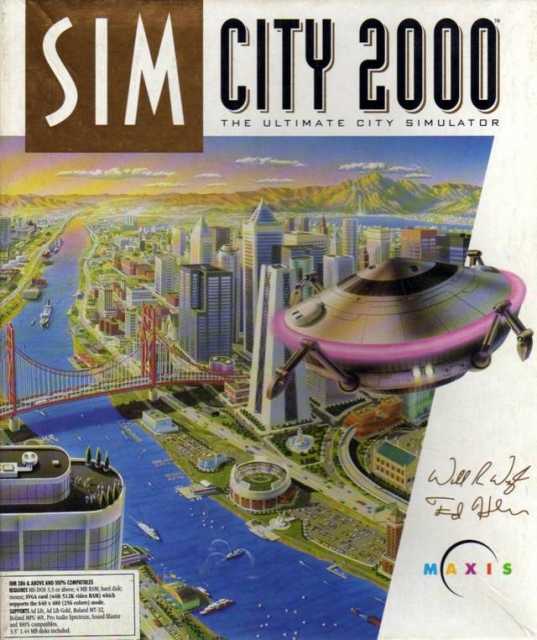Overview
SimCity 2000 is the second game in the SimCity franchise, first released in 1993 for Mac and DOS. A Windows playable version, SimCity 2000 Special Edition, was released in 1995. SimCity 2000 was also ported to many consoles, ranging from the SNES to the GBA, and is also available on PSN.

SimCity 2000 adds many features that were missing from the original. With new tools in transportation, zoning, and infrastructure, as well as a isometric view and a smoother UI, SimCity 2000 gives players more freedom than the original SimCity to create cities. With no real goal, the game instead directs players by consequence, being given a set of tools and set loose on a dynamic play area. Given enough money, the player can use the tools in any way they want, but if their cities are not generating income, the money will soon run dry. Players will find that to function, cities need utilities, civic services, transport infrastructure, and a fragile balance between homes and jobs. Playing within (and sometimes outside) the limits of the rules and seeing what works is part of the game.
Gameplay
In SimCity 2000, the player starts off with a randomly generated piece of land, which could be terraformed to their liking. The player then builds a city, providing it with necessary utilities and civic structures. They also need to balance their budget, their income coming from rent and taxes, and their expenditure from building and maintaining the city. If they run below a certain budget deficit, they will be kicked out of the mayor's office, losing the game.

There are 3 main types of buildings in SimCity 2000: Residential, Commercial, and Industrial (RCI). They are not built by the player directly. Instead, the player "zones" certain plots of land for specific development. Zones are the main type development in any city in the SimCity franchise, and what grows in those zones are determined by the amounts of utilities and services that plot can receive, and the land value of the area. Players can also zone landfills, air and seaports, and military bases. These zones are not as affected by land value as RCI zones but they will drastically affect their surrounding areas negatively.
Land value is an important factor in SimCity 2000, and can be raised or lowered by the presence or absence of water features, trees, and pollution. It can also be affected presence or absence of civic structures, power and water supply, and good transport infrastructure. Rewards, special buildings given to the player for reaching certain population milestones, also help to boost land value of the area.
Arcologies
Arcologies are special futuristic buildings, rewarded to players once they reach a city population of 120,000 and they are after the year that they are invented. There are 4 arcologies in SimCity 2000: Plymouth Arco, Forest Arco, Darco, and the Launch Arco. Arcologies provide the city with a huge boost in population, the smallest one (Forest Arco) providing 30,000 residents, and the mighty Launch Arco giving a massive 60,000 residents.
Launch Arcos also have a special effect. After building 300 Launch Arcos, a special message "The exodus has begun." will appear, and the they will "launch" (in reality, just explode). The player will then be compensated for the construction costs after all the Launch Arcos have been launched. This only occurs in the PC and Mac versions of the game.
Disasters
Disasters will hamper a player's construction of their cities (unless they turned it off). These disasters are random, and range from mundane (a fire), to the extreme (monster invasions). Players can also activate these disasters purposely to destroy their cities for fun. There are 8 disasters in the game:
Fire: An inferno blazes through the city. Fire stations help put it out.
Flood: Waters flood into the city. Dispatch emergency services to limit floods.
Air Crash: A plane crashes into the city and starts fires.
Tornado: A rampaging tornado rips up trees and buildings.
Earthquake: An earthquake destroys both buildings and underground infrastructure.
Monster: A giant sphere with an huge eye descends on the city, and sets things on fire with its laser beams.
Hurricane: A hurricane destroys buildings and cause flooding.
Rioters: Unhappy Sims protest on the streets and start fires. Police presence helps to limit rioting.
Scenarios
SimCity 2000 comes with 6 scenarios, where the player can take over an existing city (either fictional or based on a real city) and try to solve its problems. They are: Charleston, Dullsville, Flint, Hollywood, Oakland Hills, and Davenport. An additional scenario pack was also released for the game, Scenarios Vol 1: Great Disasters. As the name suggests, players have to battle disasters in 12 new cities: Atlanta, Barcelona, Chicago, Davenport, Homestead, Malibu, Manhattan, Oakland, Portland, San Francisco, Silicon Valley, and Washington D.C.
Expansions
SimCity's expansions and different editions mixed and matched their content. While added content like the SCURK were initially offered only in expansions eventually they were included in separate retail packages.
Scenarios Vol. 1: Great Disasters added on unique scenarios to the original game. These included scenarios based on some real life events like major hurricanes or nuclear meltdowns. These disasters usually decimated the player city and would require and almost complete rebuild.
The SimCity Urban Renewal Kit (SCURK) is a toolset that players can use to create and modify buildings for SimCity 2000. It first shipped with the Scenarios Vol 1: Great Disasters expansion but then made its way to the SimCity 2000 Special Edition released in 1995.
System Requirements
| PC System Requirements (GOG Version) |
|---|
|

 Amiga
Amiga Game Boy Advance
Game Boy Advance Mac
Mac PlayStation
PlayStation PC
PC
























